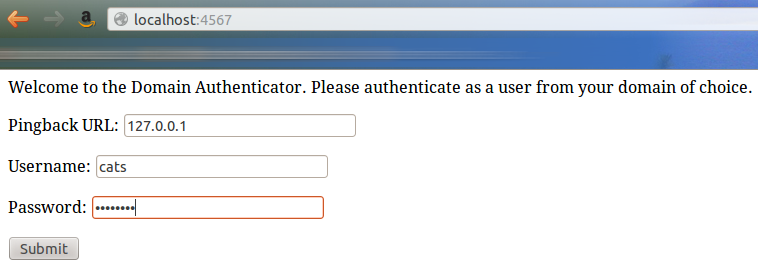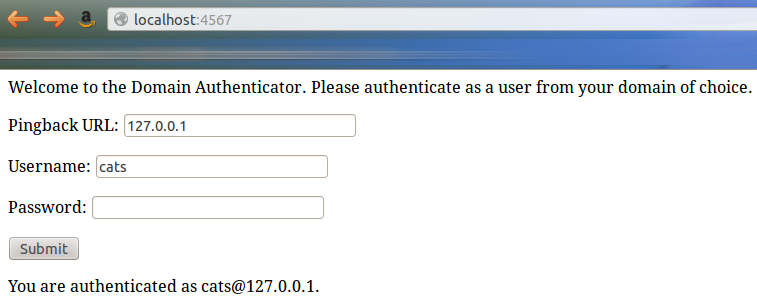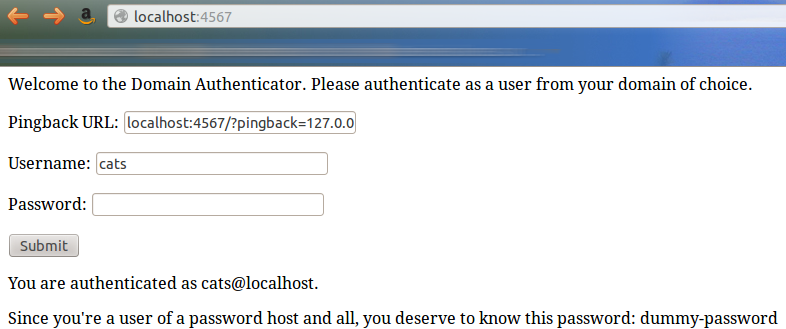Stripe CTF: Level #5
Posted on sam. 27 octobre 2012 in Write-up

You can find the code for this level here.
(sha256:
82b066cca46fd24a16959ada973d6df0d7c693f7791a8b673add276f324a5885)
This level wants to solve a real problem: identification. We have too many online accounts and we have to remember usernames/passwords for everyone of them. It would be way simpler to be able to log into a new web service using your Google account, or your Facebook account (kind of like OpenID). That's what this level is all about.
This service asks for a pingback address (it's the service you want to use to identify, like using Google or Facebook with OpenID), and your username/password to this pingback. The form will then send your credentials to the pingback and see if you're successfully authenticated.
# File srv.rb, line 20
PASSWORD_HOSTS = /^level05-\d+\.stripe-ctf\.com$/ # To get the password, the pingback must follow this regex
ALLOWED_HOSTS = /\.stripe-ctf\.com$/ # The pingback must follow this regex
Note that these regex were for the real CTF. For a local usage, here are what they look like:
# File srv.rb, line 23
PASSWORD_HOSTS = /^localhost$/ # To get the password, the pingback must follow this regex
ALLOWED_HOSTS = // # No restriction on the allowed hosts
We can only use pingback URL ending in .stripe-ctf.com, but fortunately, we still have access to the social network on level #2! We can upload a PHP file, which will always say the authentication is successful.
Note: on the next screenshots, I'll use 127.0.0.1 as the address for level #2, and localhost as the address for level #5!
So, how does the service know that we were successfully authenticated to the pingback?
# File srv.rb, line 109
def authenticated?(body)
body =~ /[^\w]AUTHENTICATED[^\w]*$/
end
So, all we have to do is upload the following file to level #2:
<?php
echo " AUTHENTICATED \n";
?>
Let's fill the form to use level02-[numbers].stripe-ctf.com
as a pingback:

We submit, and here are the result of the authentication...

...and the new login page:

Okay, now we can authenticate using this script, but we can't recover
the password, cause the URL is
level02-[numbers].stripe-ctf.com, and not
level05-[numbers].stripe-ctf.com. The key is to see how the
server recovers the pingback URL we give him:
# File srv.rb, line 67
pingback = params[:pingback]
username = params[:username]
password = params[:password]
[...]
# File srv.rb, line 80
body = perform_authenticate(pingback, username, password)
[...]
# File srv.rb, line 99
def perform_authenticate(url, username, password)
$log.info("Sending request to #{url}")
response = RestClient.post(url, {:password => password,
:username => username})
body = response.body
$log.info("Server responded with: #{body}")
body
end
The server uses params to recover the informations sent by
the form. Then it POST s the username and the password to the
to the pingback URL. But params is the Ruby equivalent of
$_REQUEST in PHP, which recovers the informations sent by
POST, but also by GET. So let's say we put this as
a pingback URL:
http://leve05-[numbers].stripe-ctf.com?pingback=http://level02-[numbers].stripe-ctf.com.
Okay, here is where it gets tricky: the server retrieves the previous
URL as a pingback. It then posts our username/password to it, i.e. to
itself, since the address is
level05-[numbers].stripe-ctf.com. So the server finds itself
with a username/password by POST, and a pingback (the level
#2 URL) by GET. So it does its business: sends the
username/password to the pingback.
First we fill in the login:

Then we submit:

We clearly see here that the server was interrogated twice.
And we just have to go back to the login page:

w00t!